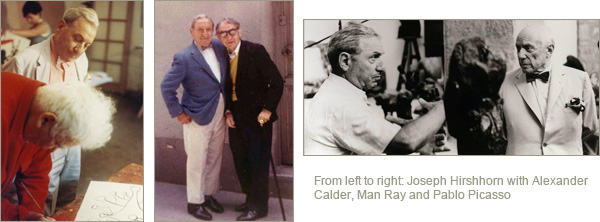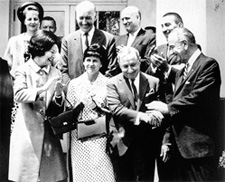History of the Hirshhorn
Below is a timeline documenting the History of the Hirshhorn Museum and Sculpture Garden from 1960 to the present. The timeline, along with further information on Joseph Hirshhorn, the founding donor, and Gordon Bunshaft, the museum's architect, is also available in a printable rich text format (.rtf) file.
Joseph H. Hirshhorn

The Hirshhorn Museum's founding donor, Joseph H. Hirshhorn (1899–1981), immigrated to New York from Latvia when he was four years old. His widowed mother settled with her thirteen children (Joseph was the twelfth) in the Williamsburg section of Brooklyn.
In time, Hirshhorn would become a financier, philanthropist, and well-known collector of modern art whose gift to the Nation of 6,000 paintings, sculptures, drawings, and mixed-media pieces established his namesake museum on the National Mall. It has been open to the public since 1974.
At the age of thirteen, Joseph left school to become a newsboy. Two years later he took his first salaried job, on Wall Street in Manhattan, earning $12 per week. At sixteen, he launched his career as a financier by using his savings of $255 to become a stockbroker.

When he was eighteen, Hirshhorn acquired his first works of art: two etchings by the 16th-century German artist Albrecht Dürer, purchased for $75 each. This acquisition marked the beginning of a lifelong passion for collecting art, assisted by an innate talent for making money. In the late 1940s, Hirshhorn's mining investments in uranium-rich Canadian land cemented his status as a wealthy man.
Hirshhorn eventually turned his attention to the art of contemporary masters. He became an avid collector of works by living painters such as Arshile Gorky, Stuart Davis, Edward Hopper, Milton Avery, Raphael Soyer, and Larry Rivers. He socialized and visited with many of these artists and assisted them when he could-helping his friend Willem de Kooning, for example, finance the construction of a Long Island studio in exchange for works of art.
As a collector, Hirshhorn also went after works by American painters of the late nineteenth and early twentieth centuries. Thomas Eakins, Louis Eilshemius, Ashcan School artists, and first-wave modernists in touch with European developments are prime examples.
Hirshhorn was a frequent and welcome visitor in the studios of those whose works he collected, and many of these visits were commemorated in photographs. One such occasion was a 1966 visit to Pablo Picasso at Mas Notre Dame de Vie, near Mougins, in the south of France. Bearded photographer Edward Steichen was a guest of the Hirshhorns at their house: Villa Lou Miradou, in Cap d'Antibes.
Ultimately, Hirshhorn was perhaps best known as a collector of 19th- and 20th-century sculpture. He acquired major works by pioneers such as Auguste Rodin and Constantin Brancusi, as well as innovative contemporaries including Alexander Calder, Henry Moore, and Alberto Giacometti. Developing fast friendships, Hirshhorn showed his enthusiasm in numerous ways: by visiting Moore's studio, for instance, and enjoying the art scene with Giacometti.



The breadth of Hirshhorn's sculpture collection was unknown to the general public until 1962, when selected works were loaned to the Guggenheim Museum in New York for a major exhibition. Several international museums and governments courted Hirshhorn, but his comprehensive modern art holdings ultimately went to the Smithsonian Institution. Lady Bird Johnson, wife of then-President Lyndon B. Johnson, played a supporting role by paying personal visits to Joseph and his wife, Olga. After an Act of Congress established the Hirshhorn Museum in 1966, the Johnsons joined the Hirshhorns for the museum's groundbreaking in January 1969, just prior to the inauguration of President Richard M. Nixon.
Among the numerous honors afforded this self-made philanthropist during his lifetime was, appropriately, the Horatio Alger Award in 1976. The award is designed to honor determination, perseverance, and success in the face of adversity.
Dividing his time between Washington, DC, and Naples, Florida, Joseph Hirshhorn remained a vigorous art collector and patron until his death in 1981. His subsequent bequest to the museum nearly doubled the size of the collection. Building on this nucleus of Hirshhorn artworks, curators keep current on new art while refining the collection, which today numbers some 12,000 pieces. A constant stream of new acquisitions, including curators' purchases and gifts of art from many donors, extends the Hirshhorn legacy of passion for new art.



